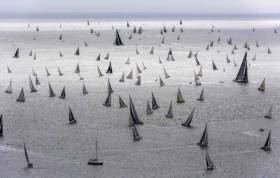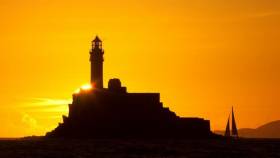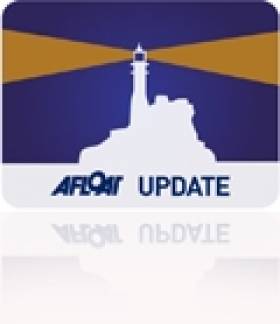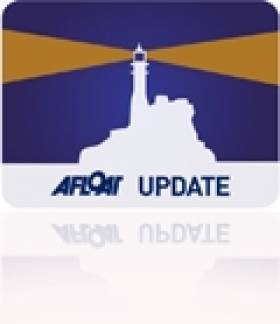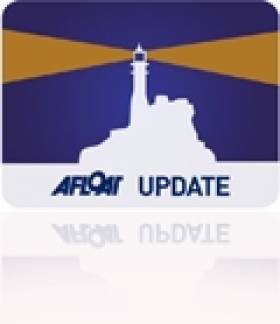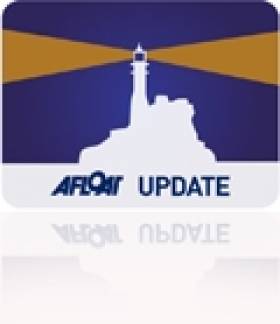Displaying items by tag: Fastnet
Fastnet Race Set to Attract Another Massive Offshore Fleet
The world's largest, most prestigious offshore sailing event will take place this summer off the Irish south coast with the 47th running of the Rolex Fastnet Race.
Some offshore yacht races struggle for entries, but the Royal Ocean Racing Club's biennial flagship event is not one of them. When the entry list opened on 9 January, spaces sold out faster than a Rolling Stones farewell concert; the 340 boat limit reached, incredibly, in just 4 minutes and 24 seconds. And this figure excludes the non-IRC fleets which will include a giant international turn out of Class40s and significantly, will be the first occasion the eight VO65s, set to compete in this year's Volvo Ocean Race, will line up in anger.
When the Rolex Fastnet Race set sails from Cowes on Sunday 6th August, close to 400 boats will make up the combined IRC and non-IRC fleets - the largest ever entry in the race's 92 year history and a significant step-up from 356 in the last race.
So why is the race so successful? "It is within easy access for the largest fleets of offshore-capable yachts anywhere in the world," succinctly explains Nick Elliott, Racing Manager of the RORC.
The Rolex Fastnet Race is one of the world's oldest offshore races, but the 605 mile course represents much the same challenge today as it did to competitors 90+ years ago: Typically an upwind westbound slog along the south coast of England, then full exposure to the open Atlantic Ocean on the crossings to the Fastnet Rock (lying four miles off southwest Ireland) and back, before leaving Bishop Rock and the Scilly Isles to port, en route to the finish off Plymouth.
However today, the standard of yachts and their equipment have improved immeasurably, as have the safety and qualification requirements for competing yachts and crews. This, combined with weather forecasting becoming a more exact science are all designed to prevent a repeat of the 1979 race, when a storm of un-forecast severity devastated the fleet and cost 15 crew their lives.
The modern day Rolex Fastnet Race fleet is also the most diverse, with yachts of every conceivable type represented. These range from the 100ft long Ultime trimarans, the fastest offshore race boats in the world, to the Volvo Ocean Race one designs, to the IMOCA 60s, used in the Vendée Globe singlehanded non-stop round the world race, while, with thirty four boats entered, the Class40s will be by far the biggest non-IRC class.
Meanwhile some of the world's most prominent grand maxis will be competing in the main IRC fleet. The longest is the Judel Vrolijk 115 Super Maxi, Nikata, while Ludde Ingvall is bringing his radical DSS-equipped 100 footer CQS all the way from Australia and one of the race favourites will certainly be George David's Rambler 88, that just missed out on line honours in 2015.
But making up the bulk of the IRC fleet are the Corinthian entries. Nick Elliott explains: "The Rolex Fastnet Race has that 'challenge appeal' which people are looking for more and more at the moment. It's something people can tick off their 'list'. Also, there are lots and lots of boats available for charter and spaces available for individuals who want to do it. Generally instead of people going racing every weekend, these days they'll cherry pick, they'll choose to only do bigger, more special events."
A lot are crewed by families and friends or yacht club teams, many of whom come back year after year.
For example Tony Harwood is returning for his sixth race and his fourth on board Volante, a 1961 Camper & Nicholson 38 footer, in her day a Morgan Cup winner. In 2009 Volante claimed the Iolaire Block for being the 'oldest yacht to complete the course', while this year she is the lowest rated boat in the race (IRC TCC of 0.855).
So what is the attraction of the Rolex Fastnet Race? "It's like 'why climb Everest?' Because it's there, I suppose," explains Tony Harwood. "We are heavy old crew in a heavy old boat, but we do about 5,000 channel miles a year. I like competitive sailing, even though the starts frighten the life out of me."
It is also a 'father and son' affair, although son Simon races their Prima 38 Talisman. "It's never the same," says the younger Harwood. "It is different every time and you always try to do better than last time. About half of the times I've seen the Fastnet Rock in daylight - two years ago it was thick fog and in 1999 there was the solar eclipse. Also it is a talking point. 'Did you do the Fastnet?' 'How was it?' That all brings me back every couple of years."
When his father last competed aboard Volante in 2009, she finished in just under six days, while Talisman made it round in four days 7 hours and 46 minutes in 2015. A boat that in 2015 was comfortably finishing in Plymouth at roughly the time Talisman was still outbound to the Fastnet Rock and slower Class 4 boats were just passing Land's End, was Tony Lawson's Concise 10. The MOD70 trimaran class completed their race in a mere 2 days 17 hours 35 minutes, although this was slow, way off the multihull race record of 1 day, 8 hours and 48 minutes.
"That was the first big offshore race we did with the boat," recalls skipper Ned Collier Wakefield. "It was pretty light, so we'd like to do a faster race. We should be able to do it in 26 hours if the conditions are right. The Rolex Fastnet Race is a prestigious race, it's one of the big ones for us and it is nice do a 'home race'."
Concise is also planning on entering its Class40.
The 2017 Rolex Fastnet Race sets sail from the Royal Yacht Squadron line to the north of Cowes at 1200 BST on 6th August.
Exceptional Take Up for 47th Rolex Fastnet Race Makes It A Record
Entry into the Royal Ocean Racing Club's flagship event, the Rolex Fastnet Race surpassed expectation today in record-breaking time. The 340-boat limit was reached in just 4 minutes and 24 seconds setting a new record.
Within the first minute of the REMUS online entry system opening at midday today (Monday 9 January), the London and Cowes-based organising club had received a massive 222 entries. The frenetic trend continued for the next hour and into the afternoon, with entries streaming in from all around the world. Within an hour, nearly 400 boats had signed up for the biennial 603-nautical miler, which has been an established fixture on the ocean racing circuit since 1925.
Nick Elliott, RORC Racing explains his reaction to the phenomenal demand to enter this historic race:
"The take-up of entries for the 2017 Rolex Fastnet Race has been incredible. We expected to better the time it took to reach the limit in the last race of 24 minutes, but this is amazing. It just exemplifies how sought after the places in the race are and confirms that it is a real sporting institution; one which every sailor wants to tick off their personal 'bucket list'.
"Seven boats raced in the first race in 1925 and the founding members of the RORC and its flagship event would have been in awe of their creation with 340 boats signing up so quickly today. With all this interest, we expect a record-sized fleet to start from the Royal Yacht Squadron line, making the Rolex Fastnet Race by far the largest of the world's classic 600-mile offshore races, in terms of participation. One not to be missed," continues Elliott.
The First 40, Lancelot II was the first boat to enter the race, signing up just 12 seconds after the online entry system opened. The next four boats entered shortly after: Arthur Logic, Pelgrim, Jolly Jack Tar and Moana. Entries from 28 different nations have signed up and include; Great Britain, France (who have dominated the event in the recent years), Netherlands, Germany and USA, with an entry from Korea as well as from Australia and New Zealand. The race has attracted the usual diverse fleet of yachts, from beautiful classics to some of the world's fastest racing machines - and everything in between, racing in IRC or selected offshore classes such as IMOCA60, VOR65, Class40 and MOCRA Multihull.
The 47th edition of the Rolex Fastnet Race organised by the Royal Ocean Racing Club will start in the Solent from Cowes, Isle of Wight, on Sunday 6th August, finishing in Plymouth via the Fastnet Rock, the symbol of the race located off the southern coast of Ireland.
RORC Relax Fastnet Race 100 foot Limit for 2017 Race
The Royal Ocean Racing Club, organisers of the Rolex Fastnet Race starting on Sunday 6th August 2017, has relaxed the limit of a maximum monohull length of 100ft (30.48m).
The biennial event is the world's biggest offshore race and the last edition attracted a record-sized fleet of 356 starters. The 47th race is expected to be no different, with a diverse fleet of yachts from around the world eager to secure a spot when the online entry system opens at midday (UTC) on 9th January 2017. Such is the draw of this classic 600-mile race, it was oversubscribed in under 24 minutes last time round!
Following interest from a number of superyacht owners and skippers wishing to take part in this classic offshore race, the RORC Race Committee has elected to lift the 100ft (30.48m) monohull limit opening the race up to the new breed of fast and agile cruiser/racer designs such as Peter Harrison's beautiful Farr designed ketch Sojana, the new Swan 115's and Baltic 115's, to name but a few. These yachts are regularly seen on the superyacht race circuit and have always been eligible to race in another RORC classic 600-miler, the annual RORC Caribbean 600 from Antigua.
In the last Rolex Fastnet Race there were two monohulls at this upper limit of 100ft: Mike Slade's British Farr 100, Leopard who was competing in his 5th consecutive race and from the United States, Jim and Kristy Hinze Clark's Maxi Comanche. The 100ft Comanche was the fastest monohull finisher in 2015, but narrowly missed the chance to break Ian Walker's VO70's 2011 monohull race record of 42 hours 39 minutes.
New Solo Fastnet Offshore Race Added to the 2016 Calendar
As Howth’s Conor Fogerty closes out the final few miles of the ARC Transatlantic Rally at the helm of his Jeanneau Sun Fast 3600 Bam, we can reveal the former Clipper skipper is among 46 single-handed sailors listed as provisional entries for the first soloFASTNET next July. The Solo Offshore Racing Club (SORC) have announced the soloFASTNET, a brand new offshore race on one of the world's most demanding ocean race courses. Starting off Cowes on July 2, 2016, the fleet will navigate the 610NM course west along the English south coast, across the Celtic Sea to the Fastnet Rock off Ireland, south around the Scilly Isles and to the finish off Plymouth.
The soloFASTNET is a handicap race under IRC with the option, subject to interest, to include one design classes. The Solo Offshore Racing Club prides itself on an ethos of safety and good seamanship. All boats must meet ISAF Category 2 Regulations, AIS ClassB and Personal Locator Beacons (PLB) and YB trackers are mandatory and all competing skippers will be required to have substantial short handed offshore experience.
In less than a month from the soft launch of the website provisional race entrants already total an outstanding 46 yachts. A broad range of skipper nationalities sporting a wealth of shorthanded experience have registered, including Australia, UK, France, Belgium and Ireland. The latest list of interested boats and skippers can be viewed on the website.
The soloFASTNET has been certified by the Royal Western Yacht Club of England (RWYC) as an official qualifier for their 2017 OSTAR race. The RWYC will host the soloFASTNET prize giving and post-race party in their clubhouse.
More information here
IMOCA 60s Test New Foils in Rolex Fastnet Race
#fastnet – One reason the Rolex Fastnet Race is the world's biggest offshore yacht race - at present 390 boats are entered - was the decision of the Royal Ocean Racing Club to include non-IRC offshore classes: Volvo Ocean 65, the Class40, IMOCA 60, Multihulls, the latter three have their origins or being most popular in France.
The IMOCA 60s' participation this year will be particularly special as it will be the first time some of the newest generation boats destined for next year's Vendée Globe will line up. Of the 13 IMOCA 60s racing, four are new, built to the latest iteration of the IMOCA rule requiring one design masts and keels. But their most discussed feature is their giant new L-shaped foils, designed to not only to in prevent leeway, but also to operate like Dynamic Stability System-style foils, ie protruding from the leeward side of the boat to create vertical lift, added righting moment and ultimately enhanced performance.
All four boats are VPLP-Verdier designs: Banque Populaire and Hugo Boss, of Armel le Cleac'h and Alex Thomson respectively, who finished in second and third place in the last Vendee Globe; St Michel-Virbac of two time Barcelona World Race winner Jean-Pierre Dick and the latest Safran, sailed by the team's new skipper Morgan Lagravière.
This will be Lagravière's first ever Rolex Fastnet Race and the 28-year old former Figaro sailor is excited: "It is a really famous race and this time will be interesting because it will be a test against the other new IMOCA boats." He is also looking forward to being on the start line among such a huge pantheon of top offshore racing boats from around the world.
Of the new Safran, he says: "It is between a Moth and a classic boat. It is not a flying boat - it is still an eight ton boat! It is too early to say anything about the foils because they are so new. We feel the boat is faster off the wind."
A number of turboed older generation IMOCA 60s are racing including PRB of 2004 Vendee Globe winner Vincent Riou, Maître Coq (ex Banque Populaire) of three time Solitaire du Figaro winner Jeremie Beyou and the former MACIF (winner of the last Vendee Globe and defending Rolex Fastnet Race champion), now called SMA and skippered by Paul Meilhat.
Then there is Tanguy de Lamotte on Initiatives Coeur, sailing his third Fastnet: "I have done it twice and I've won it twice - I am undefeated!" he muses, having won in the Class40 comfortably in 2009 and less so in 2011 when his boat was first of four boats that finished within one minute.
"It is great once in a while to mix big boats, small boats, professional and semi-amateurs - because people doing the Fastnet aren't amateur: It is a broad section," says de Lamotte, whose 2008 generation Farr design, was originally PRB. "The Fastnet Race is very famous in France. It is highly regarded, which is why so many people from outside of England come to do it."
Unusually the normally French-dominated multihull and Class40 classes on this occasion aren't French dominated, in numbers at least. For example in the former, Route du Rhum legend Lionel Lemonchois on the 80ft trimaran Prince de Bretagne will be up against three MOD70s, but none French. They include Musandam-Oman Sail, winner of the RORC's Sevenstar Round Britain and Ireland Race last year, the electric lime coloured Phaedo 3 of American Lloyd Thornburg and the latest recruit to Tony Lawson's Team Concise stable, Concise 10, skippered by Ned Collier Wakefield.
Team Concise is also fielding two Class40s, their Ker-designed Concise 8, being skippered by the young talented Jake Trigger, while Concise 2 has been rebranded Hed Kandi, after the Ministry of Sound's record and events company. She will be campaigned by round the world sailor Phillippa Hutton-Squire and an all-girl crew, including former 420 World Champion Annabel Vose.
Surprisingly only seven of the 20 entries are French, the favourite being Marc Lepesqueux on the Pogo S3 L'Express-Les Conquérants de Normandie. The strongest competition includes the two Concise boats, plus Dragon of American Michael Hennessey, the Kiwi 40 Visit Brussels of Belgium singlehanded round the world sailor Michel Kleinjans and the Mach 40 Stella Nova of German Burkhard Keese, all currently competing in the Transatlantic Race from Newport, RI to the Lizard. Then there is Gonzalo Botin's Tales II from Spain, which nearly won in 2013.
"We're amateur sailors with tough demanding professions, only allowing so much time for sailing," explains Franssens. "This will be our fourth Fastnet in the Class40, which we love! With our busy lives it is just manageable and in the Class40 you always have a nice fleet with hot competition. Once you have raced offshore in a Class 40, you'll never go back to the weather rail!"
In the last race they finished seventh and hope to do better with their new boat.
Last but not least are two of the Rolex Fastnet Race's latest entries: both Volvo Ocean 65s, fresh from the recently finished round the world race in Dongfeng Race Team, with its Franco-Chinese crew led by Charles Caudrelier, and the all-women's crew on Team SCA.
#fastnet race – Two months out from the start of the Rolex Fastnet Race, the Royal Ocean Racing Club has made public the latest entry list for its biennial 600 mile race from Cowes to Plymouth, via the Fastnet Rock, starting at noon on Sunday 16th August. The race was recently featured on Afloat.ie when WM Nixon traced the race origins back to Great Cork sailor Harry Donegan.
The entry list makes for impressive reading in terms of scale, diversity and quality of the fleet taking part, confirming the Rolex Fastnet Race's position as the world's biggest and most popular offshore race by far. And there are some Irish boats and sailors participating among them Conor Dillon who will race Two Handed with his Father Derek on their Dehler 34, Big Deal.
As of today there are 387 boats entered with a further 74 on the waiting list. If all the boats currently entered were put bow to stern, the line from Cowes would stretch two thirds of the way across the Solent to the mainland (1635.75m).
The bulk of the fleet - 340 entries to be precise - are competing under IRC for the race's overall prize, the Fastnet Challenge Cup. With the two American maxis: Jim and Kristy Hinze Clark's 100ft Comanche and George David's Rambler 88, due to be the pace setters on the water, the IRC fleet will, in due course, be divided into classes and class sub-divisions.
The remaining 47 are not competing under IRC but represent some of the world's leading professional race boat classes. These include the latest generation foil-born IMOCA 60s, lining up for their first major event in the build-up to next year's Vendée Globe, plus a large and highly competitive fleet of Class40s. Then there is the 13 strong multihull class featuring Dona Bertarelli and Yann Guichard's 40m long trimaran, Spindrift 2, the world's fastest offshore sailing yacht; in 2009 she covered 908.2 nm (ie 50% further than the Rolex Fastnet Race course) in 24 hours at an average speed of 37.84 knots and in 2011, as Banque Populaire V, set the Rolex Fastnet Race multihull record.
The average size of yacht competing in this year's Rolex Fastnet Race is 44.34ft (13.52m) with Spindrift 2 being the largest multihull, Comanche and Leopard the longest monohulls at 100ft and at the smallest end of the fleet, three 30ft yachts including Myles and Ashley Perrin's Capo 30, Santana from California.
In IRC rating terms, Comanche and Rambler 88 lead the charge with Time Correction Coefficients (TCC) of 1.973 and 1.869 respectively, while the slowest boat in the fleet is Tony Harwood's Nicholson 38, Volante, on 0.864 (the minimum permitted TCC this year is 0.850).
An impressive 52 entries are sailing two handed, up from 45 in 2013 when the race was won for the first time in its history by a two handed crew: French father and son, Pascal and Alexis Loison aboard their JPK 10.10, Night and Day.
Hoping to emulate the Loisins' performance this year is another father and son crew, Derek and Conor Dillon from Listowel in southwest Ireland, who are competing on their Dehler 34, Big Deal. Despite owning the boat for 10 years and campaigning her in many regattas in Ireland, the Dillons have only recently ventured into offshore racing, but nonetheless won the Two Handed class in last year's Round Ireland Race. With the Fastnet Rock on their doorstep in Kerry, the RORC's flagship event was an obvious ambition.
As Conor puts it: "We have rounded the Fastnet many times and always dreamed of doing it in the Rolex Fastnet Race. This will be a memorable moment for us for sure. I just hope it happens in day time...
"Every year we are trying to go bigger and bolder. This is an opportunity to compete in a legendary race against the best the world has to offer as well as, of course, making lifetime memories together. There are some seriously talented sailors in this race. You can give it your absolute all, and still not touch the leaders."
Among the present line-up 180 boats will be competing in the race for the first time, while 163 took part in 2013. Some of the most regular participants are Dutch old hands such as Piet Vroon, winner of the race in 2001 and, at the tender age of 85, back this year with his latest yacht, Tonnerre 4. Then there's Harry Heijst who has raced his classic Royal Huisman-built S&S 41, Winsome, in seven Fastnets, the first back in 1999.
"The most memorable Rolex Fastnet Race for us was in 2005 when we won Class 2 and came fourth overall," recalls Heijst. "We were looking good for a first overall until three Class 4 boats suddenly got a lot wind at the Lizard and beat us in."
Celebrating its 90th anniversary in 2015, the RORC, for the first time, gave their members priority entry to the race. RORC Commodore Michael Boyd expressed the delight of the club at the overwhelming interest in its flagship event: "Naturally, we are delighted with the enormous interest in the 2015 Rolex Fastnet Race. We now expect almost 400 starters and may have to disappoint many currently on the waiting list. Of course, there is a way to avoid a let-down in 2017...join RORC! I will be aboard Peter Rutter's Grand Soleil 43, Quokka 8, in IRC 2 as we continue our 'joint adventure' and we hope to have our cruising boat, Southerly, to welcome finishers in Plymouth."
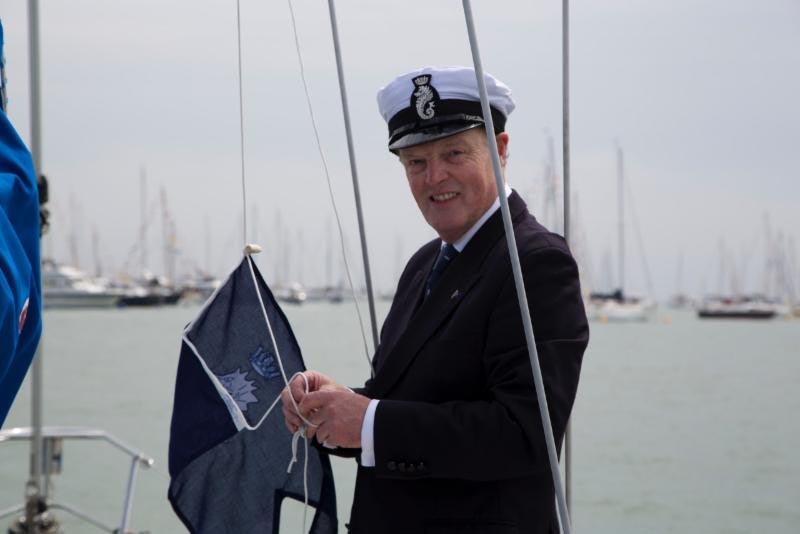
RORC Commodore, Michael Boyd from Dun Laoghaire on board Contessa 32, Olivia at the recent RYS Fleet Review bicentenary celebrations
#fastnet race – This year's 90th anniversary edition of the mighty Fastnet Race on August 16th will see a record fleet including two of the world's very newest maxis – Jim & Kristy Hinze Clark's 100ft Comanche and George David's exceptionally quick 88ft Rambler 88 - lining up against the likes of Mike Slade's veteran 100ft Leopard, which took line honours in 2007 and 2009.
In addition to the demands of racing, they're taking on a challenge of rugged sailing which George David knows only too well, as his Rambler 100 capsized at the Fastnet Rock itself in 2011's race after losing her canting ballast keel.
Whether with canting keels or using more orthodox methods of stability provision, the astonishingly varied 350-plus international fleet will be celebrating a great course and a major event which is now central to the panorama of world sailing. It is difficult to imagine the global sailing programme without the Fastnet Race in its biennial position of major importance. Yet getting it up and running in 1925 was a dogged struggle, worked through amidst fierce controversy.
And in contrast with today's large and totally international fleet, the "founding flotilla" was just seven boats, while the nearest it could claim to having an international element was through the presence of the 43ft cutter Gull from Cork. In unveiling Gull's distinctive contribution to the establishment of the Fastnet Race, W M Nixon begins by introducing us to an American description of Gull and her skipper. This colourful piece first appeared in a sailing magazine after the second Fastnet Race of 1926, and then achieved immortality by being included in Alfred F Loomis's seminal book Ocean Racing, first published 1936.
"The Gull was a plank-on-edge cutter of ancient vintage. She had a tremendous jackyard topsail, a terrific tiller, and a pack of wild Irishmen aboard her, who flogged the life out of her. As I recall, we were either first or second around the Fastnet. Shortly thereafter the mainsail started letting go and water came up over the floorboards because we'd spewed all our bow caulking. The glass dropped .80 inches in forty-five minutes, and on that came a regular Bristol Channel howler. In thick weather we groped for Baltimore, and when we got within what we estimated to be two miles and could not pick up the light, we reluctantly gave up the heroic idea of beaching the Gull there, caulking her, and still finishing. (Yes, that's the sort of skipper and crew it was!)
We hauled up for Cork Harbour, close-hauled under tri-sail and storm jib with the wind coming down now from about Sou'east, and that delightful Irish coast altogether too close under our lee. The seas were breaching clean over the old packet, and the spitfire jib – though we didn't know it – was pulling the runner eyebolt right out of the counter. We passed the Stag Rocks and they weren't more than two hundred yards to leeward; on the darkest, wildest sort of night they were plainly visible and audible, great and terrifying founts of spray just to leeward. This was possibly the closest escape I've ever had at sea, and one of the few times my life has actually been in danger.
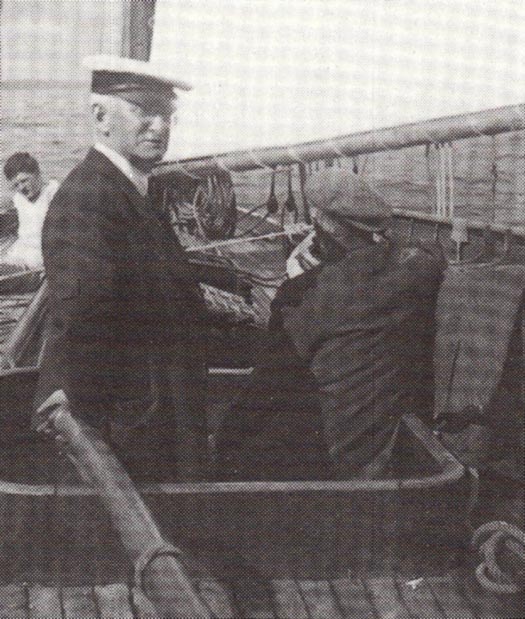
It was certainly no exaggeration to describe her as being steered with a "terrific tiller" - Harry Donegan on the helm.
Well, the old bucket held together until we put her on the mud at Crosshaven in the morning. All hands had pumped, bailed and cursed – I didn't hear any praying – all night long, and everything aboard was soaked.
While the mess was drying out in the sunlight this final morning I found my bedraggled, red-eyed, but still spunky little skipper fiddling around on deck with what to me looked suspiciously like a boy's toy. I asked him what he was doing, and his answer, s'helpmegawd, was,
"I'm flying a kite."
He went on to explain that he had meant to test out a theory that an aerial could best be carried by a kite when at sea, and so he had brought along a box-kite which had been forgotten until we started heaving the gear on deck. Discovering it at this late date, his intellectual curiosity remained strong enough to overcome the anxiety, desperate work and weariness of a rotten hard race and near-foundering.
His name is Henry P F Donegan, a solicitor of Cork, and he is one of the world's best."
Thus we have Harry Donegan and his beloved Gull, vividly remembered for all time in international sailing history. The piece may have several inaccuracies and any amount of poetic licence. But there's no doubting how it captures the spirit of a man who, with maybe just two or three others - if others there were at all – was present at both the founding of the Royal Ocean Racing Club in Plymouth at a dinner in the Royal Western Yacht Club on August 23rd 1925 after the finish of the first Fastnet Race, and at the founding of the Irish Cruising Club at a dinner in Glengarriff on July 13th 1929 after a Cruise-in-Company in West Cork. On both occasions, he had sailed there aboard Gull.
This particular account of a "rotten hard race and near-foundering" is about the second Fastnet Race of 1926, which was the first to start from Cowes. The first and decidedly controversial Fastnet Race of 1925 had only been able to secure a start from the Royal Victoria Yacht Club at Ryde, which sent the fleet out of the Solent eastabout.
The colourful yarn about the 1926 race was written by the American Warwick Tomkins, who had done a pierhead jump aboard the Irish boat at almost the last minute, and his impressions of Gull were perhaps slightly skewed. For sure, she certainly did have a "terrific tiller". Yet as she was built in 1896, she was only thirty years old at the time, which was scarcely "ancient vintage". As for being "plank-on-edge", that almost amounts to defamation - she had a beam of slightly over 10ft on an overall length of 44ft, which made her decidedly beefy by comparison with the true plank-on-edge lead-mines of the 1870s and 1880s.
In fact, Gull was a classy performance cruiser built by Camper & Nicholson at Gosport, and designed by a rising star in the family firm, Charles E Nicholson, who was twenty-eight when she was launched. But she set such an enormous spread of canvas that her shroud base had been widened by the use of channels, an archaic system which may have heightened her apparent antiquity for American eyes.
However, the "tremendous jackyard topsail" was if anything an understatement. The luff of this extraordinary sail was something like 50% longer than the luff of the mainsail. The idea of carrying - let alone sending aloft - this vast acreage of sail with its two long and heavy yards in open ocean seemed an appalling notion to conservatives who had doubted the wisdom of an "ocean race" from the very beginning.
And in truth it still seems an appalling notion to us today, with our roller furling sails and all conveniences. For us, Gull seems the epitome of labour-intensive danger-laden sailing, and in the fleet of just seven which raced in the first Fastnet, she was the only one which had any claims to be "yacht-like" – all the rest were variants on no-nonsense sailing working boats, with the eventual winner Jolie Brise being a 1913-built sailing pilot cutter which had worked out of Le Havre.

The winner of the first Fastnet Race was the former pilot cutter Jolie Brise, seen here at the fastnet while celebrating her Centenary at the Glandore Classics Regatta 2013. Photo: Brian Carlin
Failure is an orphan but success has many father, and with the 90th Anniversary Fastnet Race coming up in August with its record entry, the analyses are becoming ever more detailed in allocating the true credit for this first "Corinthian ocean race" in European waters.
In doing so, we are immediately into the problems of defining just what is meant by an "ocean race". After all, one of the earliest - if not the first - offshore distance races anywhere was from Dublin Bay to Cork Harbour, and it was sailed as long ago as 1860, the winner by a whisker being the amateur skipper Henry O'Bryen sailing the 39-ton cutter Sybil.
Then, in the final decades of the 19th Century, there were two or three Tranatlantic races – true ocean races - for enormous yachts sailed by professionals. But even though one started and another finished at Cork Harbour, they weren't seen as something to which Corinthian sailors could relate. In fact, one of the first relatively regularly-staged and truly oceanic races with amateur input was from California across the Pacific to Hawaii, inaugurated in 1906, but somehow the Transpac didn't receive the attention it deserved, possibly because it was sailed on warm water between places a long way from the true ocean – the Atlantic.
There, much more attention focused on the first Bermuda Race from New York, also in 1906, despite it having only three entries. But that had grown to twelve by 1907, yet it had fallen back to just two in 1910. The First World War intervened, then there wee two low-key revivals in 1921 and '22, but eventually in 1923 there was a serious move to revive the Bermuda Race, and the newly-formed Cruising Club of America took it under its wing. There were 22 entries, and since 1924 the 635-mile Bermuda Race has been an established biennial ocean classic.
However, in the higher latitudes and colder water of Western Europe, the yachting establishment centred around the Solent was very wary of such things. The attitude was that racers shouldn't go on the ocean, while boats fit to go on the colder parts of the ocean were incapable of meaningful racing.
But some disagreed. George Martin (1881-1945), a leading younger member of the Royal Cruising Club since 1905, was in favour of fast sailing, though it was just one of his many boat-centred interests. His family had founded Martin's Bank, while he had been awarded the RCC's premier trophy, the Challenge Cup, two years running in 1907 and 1908. These had been for intrepid ventures with a 35-ton 1903-built gaff cutter called Chance, one from his home waters in south Devon to Gibraltar and return, the other a circuit of Denmark from the same starting point, with Norwegian, Swedish and German ports being visited en route.
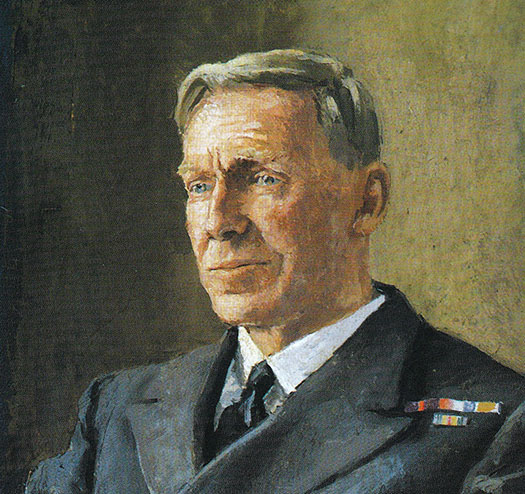
Lt Cdr George Martin OBE (1881-1945), founding Commodore of the Royal Ocean Racing Club and winner of the first Fastnet Race
Both cruises were made in fairly determined style, and Martin – a well-liked and gangling sort of man 6ft 7ins in height - had something of a reputation as a skipper who liked to push his boats to best performance. But when, eleven years later and shortly after he'd served in the RNR with distinction throughout the Great War, he began to make noises in favour of the RCC staging an "ocean race", he was rebuffed.
Things get a bit murky at this stage, as we can only go on the official club minutes, which often give a sanitized version of events. But what we do know is that in 1919 George Martin was put forward for Rear Commodore of the RCC by two very distinguished members, the maritime writer E Keble Chatterton and the already well-known cruising man George Muhlhauser, who soon afterwards was to make was to make a global circumnavigation with the 37-ton yawl Amaryllis for which he, like Martin in 1907 and 1908, was to be awarded the Challenge Cup in 1921 and 1922 (followed incidentally by Conor O'Brien with Saoirse in 1923, 24 & 25, but that's another story altogether).
Meanwhile in 1919, the possibility of the revolutionary George Martin with his wild notions of ocean racing becoming part of the RCC hierarchy seems to have caused considerable fluttering in the dovecotes of the serious cruising establishment, and Donald Cree – who had been Honorary Secretary of the RCC since 1908 but was under temporary replacement by his father Charles while he saw out his wartime service - stood against George Martin.
Despite the distinction of his proposers, Martin was roundly defeated by 129 votes to 49. The anti-ocean-racing mood of the club was clear. And as the RCC History (published for the club's Centenary in 1980) puts it: "Only a year later, and after a great deal of exertion on his part to become Rear Commodore, Cree resigned the office and again became Honorary Secretary. He was to be Honorary Secretary for the next 43 years, until 1964; in all he held the post for 52 years."
George Martin being a decent and well-liked man, he went on to do what he saw as the decent thing if he wished to persist in promoting ocean racing - he resigned from the Royal Cruising Club in 1921. However, he was Commodore of a Devon-based yacht club, the Royal South Western in Plymouth which was in process of amalgamating with the more senior Royal Western Yacht Club in the same port, of which in due course he became Commodore. This gave him some organisational muscle for further promotion of ocean racing.
By 1923 he had replaced the hefty Chance with a flying machine, the former Le Havre pilot cutter Jolie Brise. Built in 1913 and one of the last significant sailing pilot cutters built anywhere, her retirement from active work had been hastened by the accelerated technical advances in steam-driven seagoing vessels during the Great War. By 1917, Jolie Brise was redundant at Le Havre, and until George Martin took her over in 1923, her fate was uncertain as she had been of only limited use as a fishing boat.
Cometh the hour, cometh the man, cometh the boat. George Martin with the Jolie Brise needed a race of more than 600 miles from the Solent across the Western Approaches and back to Plymouth simply to express themselves. But despite his huge size, Martin was by nature diffident, and the most direct promotion for an ocean race in British waters came from a new direction entirely.
Enter offshore sailing enthusiast Joseph Weston Martyr (1885-1966), a former officer of the British army in the worst of the World War I trenches. He had worked post war in New York as a ship broker, but then took to maritime writing as a fulltime career while staying in America. In 1922, 1923 and 1924 he sailed in the Bermuda Race, the third time being aboard the schooner Northern Light. Although an error by the navigator meant they were totally last by the time they found the finish line, his enthusiasm was fired up, and he started bombarding British yachting magazines with ideas for an event of similar length on their side of the Atlantic.

Weston Martyr, whose journalistic enthusiasm for ocean racing encouraged the movement towards establishing the Fastnet Race. He is equally well remembered for his classic of sailing literature The Southseaman – the Life Story of a Schooner (1926), a partially fictionalised yarn built around his experiences with the schooner Northern Light.
Both Yachting Monthly through its editor, and Yachting World through its publisher, got involved in the growing interest, so when cruising's most respected authority, Claud Worth the Vice Commodore of the Royal Cruising, felt obliged to comment, he did so in the pages of The Field. Worth had been upset by George Martin's resignation from the RCC, and a small part of him inclined to ocean racing, for he was no slouch in getting performance out of his own boats. But he was concerned that in the heat of competition, even the most sensible amateur seamen would drive their boats too hard downwind, and he wrote:
"At the risk of making an unpopular suggestion, I venture to express a doubt which arises in my mind – are our latitudes suitable for a public ocean race?......a public race might well include some owners whose keenness is greater than their experience. If the weather should be bad, so long as there is a headwind they would probably come to no harm, for a good boat and sound gear will generally stand as much driving as the crew can put up with. But when running before anything approaching a gale of wind in a big sea in open water, conditions are very deceptive......".
Yet by early 1925 the momentum towards a race round the Fastnet seemed almost unstoppable, so as a final input to the debate, Worth suggested that if an ocean race was indeed going to be held, then it should be a true ocean event clear of the hazards of skirting any coastline, taking the fleet from the south coast of England to northwest Spain. He even offered to sail out to La Coruna or Vigo to time the boats in at the finish.
However, a small private Ocean Race Committee had been formed by George Martin, Weston Martyr recently back from America, and Malden Heckstall-Smith, the Editor of Yachting Monthly, and the course was set from the Solent to the Fastnet and thence to the finish at Plymouth. The Morning Post of 7th March 1925 announced that "the Ocean Race shall be.....sailed under the flag of the Royal Western Yacht Club". Four entries were in before the month was out, and at one stage around July1st the list of potential competitors ran to fourteen boats, including an American yawl which promised to bring an international flavour.
But in the end, on August 15th just seven started, and Harry Donegan's Gull from Cork was the nearest thing to international involvement, though she was scarcely thought of as such, as the British yachting establishment at the time would have reckoned that the Irish Fee State was only a temporary aberration.
As to whether there was any prior friendship between Harry Donegan and George Martin to encourage Gull's participation, at the moment we can only guess. George Martin had family connections in Ireland, and at one stage he was reportedly a member of the Royal St George Yacht Club. And like many other RCC members, he seems to have been familiar with the coast of southwest Ireland, and the selection of the Fastnet as the key turning mark in the new ocean race was his choice.
But although Harry Donegan was producing his own chartlets and sailing directions for the best anchorages in Ireland's southwest, and he also regularly cruised to southwest England, letters exchanged after the first Fastnet Race suggest that he and George Martin had never met before it. It was simply Harry Donegan's readiness for a good sailing challenge which drew him in.
And when the first Fastnet Race finally got under way, he was very likely the only skipper who had actually raced round the rock before. Schull Regatta had been in being since 1884, and though most sailors in Cork Harbour thought of the "ocean race" as being the annual jaunt round to Kinsale at the height of the summer, the more intrepid such as Harry Donegan had been known to race to Schull via the Fastnet.
So who was he, this Cork solicitor whose support for George Martin and Weston Maryr in their notion of a long offshore race round the Fastnet helped to launch it into a progression which has led to this year's mega-event 90 years down the line?
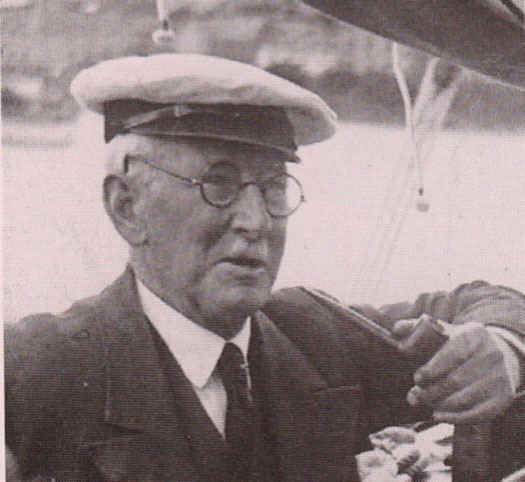
Henry P F Donegan (1870-1940), who gave his total support for the Fastnet Race from its inception in 1925.
Henry P F Donegan (1870-1940) was in his way quite a force in sailing, and in the life of Cork and Ireland. A small man of notable energy sharpened by being a teetotaler, he was playing a key role in Cork Harbour sailing from an early age. When the plans for the new Cork Harbour One Designs were being discussed with William Fife in 1895-96, Donegan was secretary to the owners' group, and though he never owned a CHOD himself, he was renowned as a helmsman in the class, and as an amateur painter he also recorded their earliest appearances.
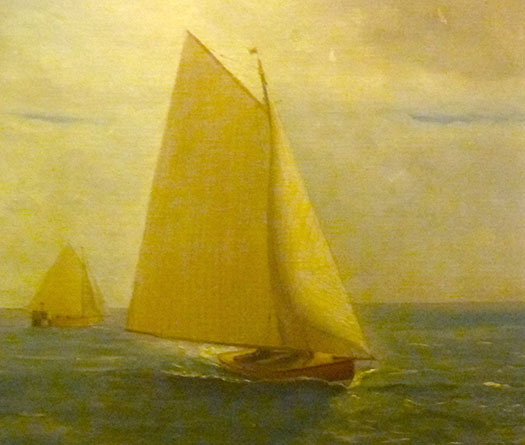
Cork Harbour One Design as painted by Harry Donegan. Although never an owner in the class, he was secretary to the class association at its foundation in 1896, and was noted as a very able CHOD helmsman.
But cruising and offshore sailing were his greatest passion, and he made some coastal ventures in very small craft. By 1912 he had produced pioneering harbour and anchorage plans for the magic places of West Cork, and this early interest in sailing directions was part of his enthusiasm for the notion of an Irish Cruising Club, though it was 1929 before he and a friend met while cruising West Cork, Billy Mooney of Howth, were finally able to bring the ICC into being.
Back in 1920 meanwhile, the Cork Harbour cruiser fleet had acquired a handsome addition, the 18-ton Nicholson cutter Gull, bought in the southwest of England. For some reason, whoever brought her to Cork had to sell her the following year, and thus in 1921, Harry Donegan acquired his dreamship, the sailing love of his life.
These were difficult times in Ireland, with the country emerging from the War of Independence only to be plunged into the Civil War of 1922, fought over the acceptance or rejection of the Treaty which had ended the War of Independence. Initially, the anti-treaty forces had control of Cork, but as the summer of 1922 progressed, the Government's pro-treaty forces under the command of Emmett Dalton gradually closed in to free the southern capital.
Communications between Dalton and his commander Michael Collins in Dublin were becoming increasingly difficult as roads, railways and telegraph lines between the two cities were disrupted by anti-treaty guerilla groups. A system had been worked out whereby communications between Dalton and Collins were carried personally by Collins' feisty sister, Mary Collins-Powell. But when all the usual means of getting her to Dublin with the vital dispatches were finally gone, Harry Donegan – who had been the leader of the pro-Home Rule Redmondite Party in Cork though not himself an active politician - offered to sail Collins' sister aboard Gull to Rosslare Harbour, where the east coast railway was firmly under government control all the way to Dublin.

Michael Collins, Commander-in-Chief of the Government Forces after Independence. As the Civil War built to its climax in West Cork in 1922, Harry Donegan carried despatches aboard Gull from the Government forces in Cork for Michael Collins at HQ in Dublin, as rebel guerillas had cut off all other lines of communication.
For this venture in early August 1922, he assembled a crew of several professional talents. Harry Donegan was a solicitor, his first mate was Dr Gerald Ahern the local doctor, and in their sailing and any spiritual needs, they were helped by the third crewman, Father Donal Murphy O'Connor.
Easterly winds hampered their progress towards Rosslare, but fortunately Government-controlled Waterford offered taxi communication with Rosslare, so they peeled off into port and soon Mary Collins-Powell and the dispatches were in Dublin and Gull cruised back to Crosshaven. With the situation clarified for the general staff in Dublin, plans could be finalized for the freeing of Cork, and Emmett Dalton and his men soon had the job done.
Which was just as well for our three heroes on the Gull. While the city may have been coming rapidly under Government control, close to the south the countryside was still full of anti-treaty units. It was Civil War in all its horror of brother against brother, friend against friend. When the crew of Gull came ashore in Crosshaven after their successful little voyage, they were promptly captured by a local anti-treaty group, and imprisoned for some days in a shed.
But up in Cork, Emmett Dalton and his fellow commanders were going about their business with such efficiency that in Crosshaven the solicitor, doctor and priest - sailors all - were soon released unharmed. Peace returned to Cork Harbour. But as the main theatre of the Civil War moved ever more remorselessly towards its bloody denouement in West Cork, Michael Collins felt he could no longer be up in Dublin, remote from events in his home county.
Despite everyone else advising against it, he came to Cork to be with his men. He spent his final night in the Imperial Hotel in Cork, and with that city already showing signs of its civilized normality, who knows but he may have had time to meet up with Harry Donegan, for everyone in Cork knew everyone else, then as now.
Next day, the Commander-in-Chief headed west on his tour of inspection, and by evening General Collins was dead, killed during a spirited exchange of fire in which he personally got involved following an ambush by men who would have been his comrades-in-arms during the War of Independence.
The Civil War was already being won by the pro-Treaty forces, but the death of Collins undoubtedly speeded its ruthless conclusion, which included the government execution in November of Erskine Childers, another noted sailing man who had become embroiled in the Troubles. By 1923, Ireland was very determinedly getting back to normality.
In its own way, sailing made its contribution. In Dublin, self-taught yacht designer John B Kearney started construction on his masterpiece, the 38ft yawl Mavis. From Foynes on the Shannon Estuary, Conor O'Brien departed in his 42ft ketch Saoirse – newly-built to his own design in Baltimore, West Cork - to sail to Dun Laoghaire to begin what was to become his epic pioneering voyage, round the world in two years south of the great Capes.
And in Crosshaven, Harry Donegan kitted out the Gull to make a long cruise to the west coast of France which so clearly demonstrated the yacht's speedy sea-keeping ability that when, towards the end of 1924, the notion was first being aired of the new 630 mile ocean race from the Solent out to the Fastnet Rock, then back to a finish at Plymouth, he was soon keen to get involved and - unlike some others - he maintained his enthusiasm and was there for the starting gun.
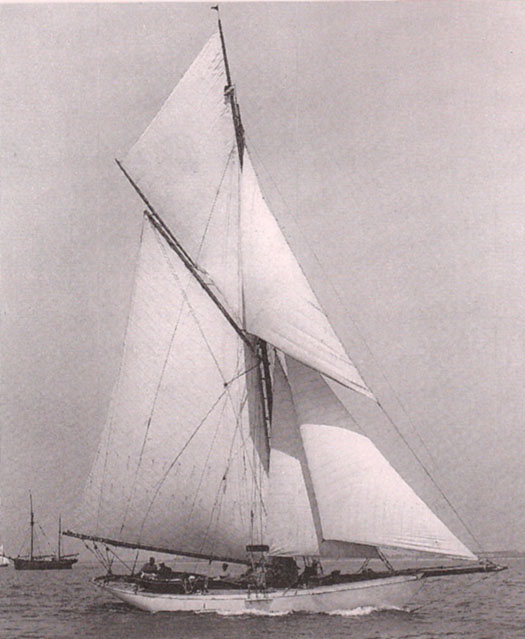
Gull at the start of the first Fastnet Race, August 15th 1925
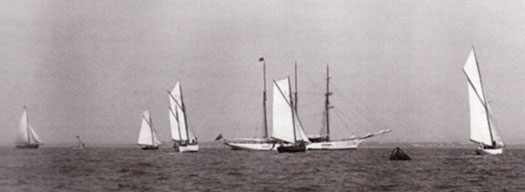
With the seven boats in the first Fastnet Race in 1925 having to beat eastwards out of the Solent from the start at Ryde, it was Gull (right) with her large sail area which soon showed ahead after making a good start. She was to lead for the first third of the 630 mile race.
In fact, Gull had the best of a fairly leisurely start off Ryde heading east out of the Solent on August 15th 1925. The Donegan cutter had much the most modern hull in the entire Fastnet flotilla, and with her huge if demanding rig, she was fastest in anything up to Force 4.
Thus she led by a good margin going outwards past the Scillies, but with sailing power soon lessened through broken topsail halyards, the succeeding stages weren't so happy, and the bigger Jolie Brise was first to the Fastnet with time in hand on the Irish boat. Heading back towards Plymouth in a freshening south'wester with the lee rail under, Harry Donegan updated his log on August 20th:
"The cabin swing-table is doing its level best to assassinate me. I have been struck in the chest and chin, while the weighty box beneath is making frantic efforts to amputate one or both of my legs"
A slight navigational error brought Gull in close north of Land's End in poor visibility, and by the time she'd made good this mistake in strong onshore winds, Jolie Brise – which was allowing her 9 hours on handicap – was well into Plymouth as the winner, while second went to the Royal Engineer's determinedly-sailed 38ft gaff cutter Fulmar, with Gull third.
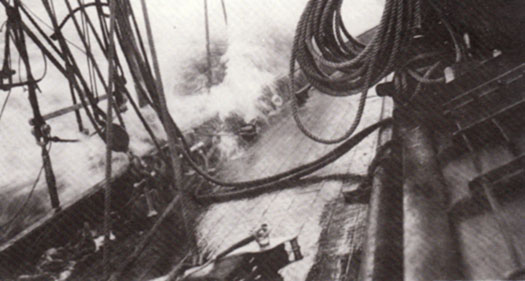
Gull making knots in the open ocean, headed for Plymouth from the Fastnet on August 20th 1925. Up-dating his log, Harry Donegan wrote: "the cabin swing-table is doing its best to assassinate me...."
Those accustomed to more recent Fastnet Races and the carnival atmosphere in the huge fleet at the finish will be intrigued by the picture Harry Donegan conveyed in the Autumn of 1925, responding to a letter from Weston Martyr, about the atmosphere which prevailed in that tiny first Fastnet flotilla as they lay to their anchors in Plymouth:
Cork, 12th November 1925
"I was exceedingly glad to get your breezy letter which was redolent of the salt sea, and may I say here that if my crew favourably impressed you, you in turn made a very lasting impression upon us all, short though our opportunities were for sizing each other up. I must say, further, that we were all appreciative of the excellent type of sportsmen that now go to constitute the Ocean Racing Club.
Take, for instance, these boys in the Fulmar. Under ordinary circumstances we, as traditional Irishmen, should have been in their wool after the finish, yet we all fell around each other's necks with the true spirit of comradeship and made merry on both ships.
Martin, needless to say, shines out as a most excellent type. We were particularly pally with the crew of Jolie Brise later, and doubtless had North Star and Banba moored near Drake's Island, we would all have fraternized in the same way.
I have raced a good deal and know the petty little feelings that sometimes prevail after the finish of an ordinary race. If one's boat has done excellently up to a point, and has then been pipped by horrible ill-luck, sometimes there is not a superabundance of joy.
Contrast that with the congenial assembly in Plymouth, and do you not share with me the impression that the Ocean Race has merits beyond the most optimistic hopes of the originators, in that it brings out the best in us and creates a feeling of good fellowship amongst the competitors that no other class of racing is calculated to do so thoroughly and effectively."
With the race successfully launched, the new Ocean Racing Club at its first formal meeting in October 1925 considered ways changing the course to make it of greater interest to yachts based outside the Solent-Plymouth nexus, but Harry Donegan was having none of it, and in writing to Weston Martyr he did much to ensure that the classic Fastnet Race was kept in place:
"I do not see how the Committee are ever going to change the course, that is if they want to stick to the 600 miles, and I confess I cannot at all see how they can ever improve on it. There is ocean sailing enough to satisfy a glutton, a freedom from sand banks, and only good honest rocks to think about."
Nevertheless we have to remember that back in the late 1920s and early 30s, it took real determination to keep it going at all, first as an annual event, and then after 1931 as biennial. Certainly there were those for whom, having done the first race of 1925, doing it again was of no interest. But Harry Donegan was one of those who considered participation in the 1926 race was essential, even if he was now 56 years old and no longer in the best of health.
The fact that he willingly took Warwick Tompkins aboard as a last-minute addition to the crew also suggests that he may have had difficulty in assembling a full ship's complement back home. And the race was now acquiring further contentious issues. There were those who still said it shouldn't happen at all, but others were so enthusiastic that boats were being purpose built for the Fastnet Race. A wealthy Scot, Norman Baxendale, had commissioned William Fife to design and build a Bermudan rigged cutter which would exactly fit the Ocean Racing Club's new upper limits of LOA70ft, and LWL50ft.
This was Hallowe'en, which was such a mighty leap forward in the concept of what constituted an ocean racer that most of the old salts considered her plain unsporting. We know Hallowe'en so very well now, for after an adventurous life on both sides of the Atlantic, she has been restored and is currently owned by an Irish syndicate who from time to time base her at the Royal Irish YC in Dun Laoghaire, though perhaps from respect for her history, the home port inscribed on her elegant counter is Cork.
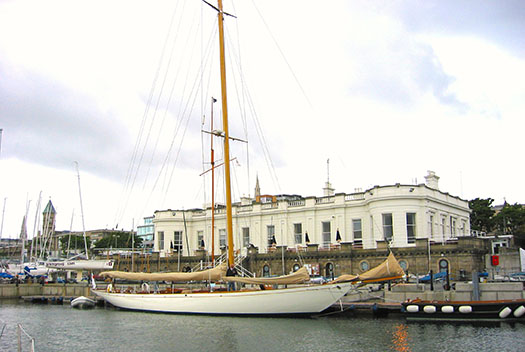
The 70ft Fife cutter Hallowe'en, which set a course record for the Fastnet Race in 1926 which stood for 13 years, and was only bested by an 88-footer. Hallowe'en is seen here at the Royal Irish YC in Dun Laoghaire, and is owned by a syndicate of RIYC members. Photo: W M Nixon
But back in 1926, with a fleet of eight boats racing the second Fastnet, Hallowe'en was so much on her own that despite some strong winds as she came in past the Lizard heading for the finish, she experienced little of the southeast gale which created mayhem out at the rock, with some boats hove to for a day and more, and Gull – which had been doing rather well, third on the water at the rock – eventually making her dramatic exit towards Cork Harbour in the intense little local low which blasted the smaller boats.
Hallowe'en established a course record which stood until 1939, by which time even larger boats were allowed to compete, and her time was bested by the Kriegsmarine's 88ft Gruber yawl Nordwind, whose German naval crew did not endear themselves to the organisers by their exuberant use of full uniform and Hitler salutes at the prize-giving. In fact, it wasn't until Ted Turner's 12 Metre American Eagle zapped round in style in 1971 that the Hallowe'en course record was beaten by a boat of comparable size.
So back in 1926 she was sensational, yet in simply designing to the upper limits, William Fife took no other account of the developing RORC measurement rule, and Hallowe'en had a rating so stratospheric that she finished third on corrected time, the winner being the 20-ton yawl Ilex, sailed by those very determined Royal Engineers.
As for Harry Donegan and Gull, that was their last Fastnet participation, but they were regular contenders in other events., particularly the RORC Falmouth-Clyde races during the 1930s when the skipper's son Young Harry was becoming involved, and of course the skipper himself was involved with huge and infectious enthusiasm for the Irish Cruising Club from its formation in 1929. In the end, passage races to West Cork and cruising that incomparable area became his fulfilling pleasure, and he'd a final magnificent sail from Schull back to Crosshaven before his death in 1940, aged 70.
His son Young Harry took up the reins, and in 1946 he sold Gull to England, and replaced her with the much racier Fife-designed Sybil from within the Cork Harbour fleet. 1947 was to be the first full year with the new boat, and he took her round to Dublin Bay for the Dun Laoghaire to Clyde Race, but tragically he was drowned when the dinghy filled in a near gale in Dun Laoghaire Harbour while returning aboard from the pre-race briefing. Like his father, Young Harry was a teetotaler, but in his tireless efforts to save his shipmates, he became exhausted and was the only one of Sybil's crew lost in this accident which reverberated sadly through Irish sailing for decades.
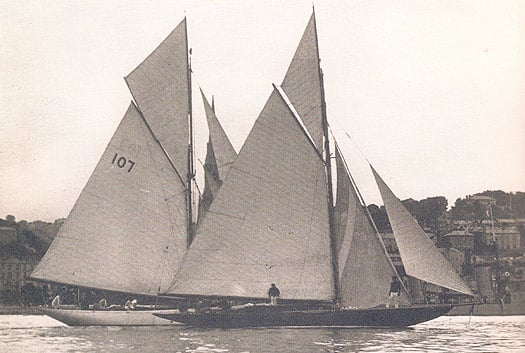
The two yachts which brought triumph and tragedy to the Donegan dynasty – Gull and Sibyl off the Cobh waterfront during the 1930s. Photo courtesy Royal Cork YC
Young Harry's eldest son Jim then became head of the clan although still only a schoolboy, but over the years he showed the family's zest for offshore racing and successfully competed in many major events in a variety of craft. And in the best family traditions, he was also busy behind the scenes becoming a founding Commodore of the South Coast Offshore Racing Association, and then a co-founder (with Fintan Cairns) of the Irish Cruiser Racing Association in 2002.
We are now five generations down the Donegan line from the great Harry P F Donegan himself, and the current most visible carrier of the torch is his great-great-grandson Jamie Donegan, who is the very highly regarded bow-man aboard Anthony O'Leary's new boat, the red Ker 40 Antix, where the Donegan contribution to winning the recent British IRC Championship was particularly noted.
As for his extraordinary great-great-grandfather, he was the man whose crisp opinion on the attractions of the Fastnet course may well have been the key to its lasting appeal. And with every passing year, his very special and innovative contribution to Irish and international sailing and the development of offshore racing and proper cruising is more fully appreciated
Harry Donegan was rightly and fondly remembered by many, not least his former shipmate Warwick Tompkins. After Gull's enforced retirement from the 1926 Fastnet Race, the skipper worked out that if they caught that night's Cork-Fishguard ferry and had a bit of luck with train timetables in south Wales and southwest England, he might just be able to get Tomkins to Plymouth in time for the Fastnet Dinner in the Royal Western.
They made it by the skin of their teeth. And at the dinner, Harry Donegan made such an impassioned little speech about the contribution his new friend had made to the saving of the Gull that his fellow members of the Ocean Racing Club waived their normal insistence on completion of the Fastnet Race as being the requirement for membership of their club. Warwick Tompkins was elected to the ORC, soon to be the RORC, with acclamation.
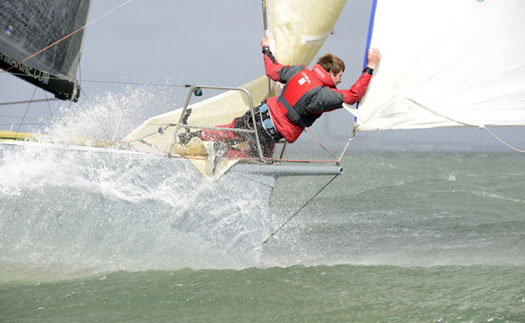
Doing that Donegan thing....Jamie Donegan, great-great-grandson of Harry Donegan, busy at his work as bowman aboard Anthony O'Leary's Antix. Photo: Rick Tomlinson
Latest Maxis Racing For Fastnet Race Bragging Rights
#rorcfastnet – While it may not be the event's ultimate prize, the monohull battle for line honours in the Rolex Fastnet Race is always hotly contested, coming with considerable bragging rights. This year's race from Cowes to Plymouth via the Fastnet Rock, coinciding with the 90th anniversary of the event's organiser, the Royal Ocean Racing Club, will see the world's two very newest maxis jockeying for this prize. Both belong to American captains of industry and both were launched last autumn.
While it may not be the event's ultimate prize, the monohull battle for line honours in the Rolex Fastnet Race is always hotly contested, coming with considerable bragging rights. This year's race from Cowes to Plymouth via the Fastnet Rock, coinciding with the 90th anniversary of the event's organiser, the Royal Ocean Racing Club, will see the world's two very newest maxis jockeying for this prize. Both belong to American captains of industry and both were launched last autumn.
Favourite is the 100ft long Comanche owned by Jim and Kristy Hinze Clark. Clark, the Silicon Graphics and Netscape founder, has owned several high profile superyachts and the magnificent J-Class yacht, Hanuman, but his latest craft is a state of the art ocean racer designed by VPLP-Verdier, best known for their IMOCA 60 designs. In fact Comanche strongly resembles a scaled-up version of MACIF, winner of the last Vendee Globe, with a powerful hull, canting keel, twin daggerboards and rudders and numerous other go-faster features.
"The Rolex Fastnet Race is one of the goals for Comanche as one of the 'Great Races' around the globe," Clark explains. "Comanche was built to do two things: Win line honours and, if Mother Nature cooperates, try to break records. Let's hope that we succeed with both, but I know there will be lots of very strong competition!"
If Comanche is to break the Rolex Fastnet Race monohull race record, she will have to complete the 603 mile long course in less than 1 day 18 hours and 39 minutes - the time set by the Ian Walker-skippered VO70 Abu Dhabi Ocean Racing in 2011.
On paper, Comanche should have a clear run at the line honours title as she's 12ft longer than George David's latest maxi - Rambler 88, designed by Juan Kouyoumdjian. David observes: "No doubt Comanche is the bigger boat and rates accordingly. We're a little off Comanche's speed through the water, but it's too soon to tell after only four day races together." To date the boats have only lined up at Les Voiles de St Barts, but in July they will compete in the Transatlantic Race 2015, between Newport and the Lizard.
David is a great fan of the Rolex Fastnet Race: "It's a great blue water race - full of tradition and with a great turning mark at Fastnet Rock. We have done the race twice before and are delighted to be coming back." And this is despite his close shave with death during the 2011 race when the keel fell off his Rambler 100, leaving him and a group swimming in the Celtic Sea. Did he think twice about returning? "It's like being chucked off a horse. You get back on," David retorts.
In terms of their performance, America's Cup legend Brad Butterworth, who is sailing master and tactician on board, reckons Rambler's strengths versus Comanche are upwind and VMG downwind. This could bode well for the Rolex Fastnet Race's typically large windward-leeward course.
But to help her prospects, Rambler 88 is currently being fitted with a secret weapon in a Dynamic Stability Systems-style lifting foil. This retractable lateral foil, is deployed on the leeward side of the boat below the waterline (like a wing), to provide lift to leeward and a gain in righting moment, like having extra crew on the weather rail. This 'turbo charger' could reduce any deficit they might have against Comanche.
"They look pretty cool," says Butterworth. "I think that any time we are over 14 knots reaching they should make a difference. It might light the thing up. The boat certainly has a lot of sail area. It will be interesting."
While all eyes will be on the latest hardware, also in the mix will be Mike Slade's Farr 100, Leopard, the maxi which claimed line honours in the 2007 and 2009 Rolex Fastnet Races.
"It is an amazing fleet with Comanche and Rambler and a few Mini Maxis," observes Leopard's skipper Chris Sherlock. "It will be very tough to get on the podium - the best we can hope for against those two new boats will be third."
Owner Mike Slade intends to run a 'corinthian' campaign this season and will not be chartering the boat for the Rolex Fastnet Race. However on board will be the usual all-star cast, led by veteran America's Cup and round the world sailor, Paul Standbridge.
At present Leopard is in refit in Hamble Yacht Services. Among her upgrades for 2015 is a modernisation of her rig including the fitting of a deflector backstay arrangement in place of her multiple backstays and checkstays.
#fastnet – The world's largest, most diverse fleet of offshore racing yachts will set sail from the Solent on 16th August in the Royal Ocean Racing Club's biennial Rolex Fastnet Race. 2015 marks the 90th anniversary of the Royal Ocean Racing Club and with it a record-sized fleet with as many as 350 boats expected to take part. Ireland's Damian Foxall will be one of many Irish sailors competing. The Round the world veteran will be on board Musandam-Oman Sail.
As ever the 603 mile course takes the fleet west along the south coast of England, across the Celtic Sea to the Fastnet Rock off the tip of southwest Ireland, south around Bishop Rock and the Scilly Isles and back east to the finish in Plymouth. Conditions on the race course can range from benign and summery to vicious and stormy and the event is well remembered for the horrific conditions in 1979 that claimed the lives of 15 competitors. Fortunately vast improvements in weather forecasting, safety and communications equipment as well as yacht design over the intervening years mean that a repeat of this disaster today is unlikely.
The Rolex Fastnet Race is also one of the most popular events in sailing: the original limit of 300 boats racing for the overall handicap prize under IRC was increased to 340 in 2013 due to the increased demand. This is more than twice as many places as the next most popular of other 600 mile races held elsewhere the world and still, when registration opened in January, all 340 places were filled within just 24 minutes! In addition to this group is the 'non-IRC' fleet, including many top grand prix race boat classes such as the IMOCA 60s, that compete in the Vendee Globe singlehanded non-stop round the world race, and the Class 40s.
As always, one of the attractive elements of the Rolex Fastnet Race is its diversity. At one end of the spectrum are the high profile professional sailing teams who congregate on the Solent from the four corners of the globe, many fielding the world's biggest, fastest, most state of the art racing yachts. At the other end are the Corinthian entries, where individual crew will be embarking on what for them will be their own personal Everest - the culmination of a season's training that will have included at least 300 miles of offshore racing (the mandatory requirement to qualify for Rolex Fastnet Race entry).
One of the important battles is the race for monohull line honours which this year looks set to be a much anticipated heavyweight bout between the two brand new American maxis: George David's 88ft Rambler 88 and the 100ft Comanche of Jim Clark. Both are brand new, launched late last year and some gauge of their form will take place when both compete in the Transatlantic Race between Newport, Rhode Island and the Lizard (and on to Cowes).
Another battle to watch out for will be the battle of the multihulls which this year includes the world's fastest race boat - the 131ft (40m) trimaran, Spindrift racing, skippered by Yann Guichard and Dona Bertarelli. In 2009 this boat covered 908.2 miles a day at an average speed of 37.84 knots and has been first home in the last two Rolex Fastnet Races.
However nipping at her heels will be the three MOD70 trimarans including Musandam-Oman Sail, skippered by Sidney Gavignet. This boat last year sailed an exceptional Sevenstar Round Britain and Ireland Race, setting not only a race record time, but also becoming the outright record holder for the Round Britain and Ireland course.
"I am looking forward to this race," says Gavignet of the Rolex Fastnet. "It is the big race of our season, so we take it seriously. It has such an impressive line-up. Races like the Fastnet are very important for sailing because it is a classic and you know that it will always be there every two years."
Once again Musandam-Oman Sail will be using the event in its continued programme of training up Omani sailors and three will be competing on board alongside Gavignet and round the world sailor Damian Foxall.
At the Corinthian end of the fleet, charter and sailing school entries are swelling in number. Typically these companies sell berths to individuals for the season enabling them to carry out their qualifications.
Hamble School of Yachting, for example, is fielding two Jeanneau Sun Fast 37s, each with six amateur crew plus a professional skipper and mate. "It is a bucket list item - something they have always wanted to do," says Director Chris Rushton of the attraction to his customers. "They are all first timers of mixed ability but a lot of them haven't done any racing before."
Their crew have already completed their ISAF Sea Survival and First Aid courses and this season will compete in the RORC's Myth of Malham, De Guingand Bowl and Cowes-Dinard-St Malo races as their qualification.
Eddie Warden Owen, Chief Executive of the Royal Ocean Racing Club explains the uniqueness of the Rolex Fastnet Race:
"The Rolex Fastnet Race is a world classic and probably the largest, most famous of its type. This year the demand has been huge with places selling out in 24 minutes and a waiting list of over 80 boats. The challenge for many is completing what can be a very tough adventure, but also its attraction for the experienced offshore racer is that they can compete with the top professionally raced yachts and have a realistic chance of winning. In 2013 the race was won by a very experienced father and son team sailing two handed which shows that anyone has a chance of winning the most prestigious race in the world calendar."
#fastnetrace – RORC Racing Manager Nick Elliott predicted 'a scramble for places' last October when it was announced that priority would be given to RORC members wishing to secure a place in the historic race celebrating its 90th year. He wasn't wrong. Just 24 minutes after the online entry system opened at midday on 12th January, over 300 boats had registered for the Rolex Fastnet Race. The frenetic trend continued and by the end of the afternoon, 375 boats had signed up for the biennial 608-nautical miler, which has been an established fixture on the ocean racing circuit since 1925.
"Within 24 hours of online entries opening in the race two years ago it was oversubscribed, and with a waiting list. We thought that was remarkable, but yesterday we reached the same number in 24 minutes! The Rolex Fastnet Race has great reverence with sailors worldwide wishing to compete in this iconic race and add it to their bucket list," says Elliott.
All is not lost for those who still wish to enter. Following the popularity of the 2013 race, when the entry limit was increased to 340 boats, the RORC Committee decided that RORC members would get priority for the first week of registration. Boats have to meet the strict entry qualification and training criteria of the race and after Sunday 18th January, all registered boats will be sorted and places offered on a first come, first served basis, with RORC members receiving priority over non-members. Boats registering after this date will be allocated places in the order in which they apply, regardless of membership.
The advice from the RORC Race Team is to register as soon as possible and a useful guide for entrants, explaining the main points needed to consider before entering - crew qualification, boat suitability and the process of entry itself - is available on the RORC Rolex Fastnet Race minsite: http://fastnet.rorc.org/race-information/guide/a-guide-for-entrants-complete-version.html
80 years on, 1935 Fastnet winner returns
Among the first boats to register their entry for the 2015 Rolex Fastnet Race was one of the best-known and loved classic yachts sailing today, Stormy Weather, the 1934 Sparkman & Stephens 52ft yawl who was named after the song. She has an illustrious racing pedigree, winning the King's Cup in the Newport-Bergen Transatlantic Race a year after she was launched, before arriving to see Uffa Fox in Cowes in 1935 and going on to win the Fastnet Race the same year.
The race had just 17 starters and Stormy was the only American entry in a fleet dominated by 13 British entries. **Although some of the British press displayed a severe case of "sour grapes" when they bemoaned the quality, and perhaps quantity, of Stormy's sails, Yachting World gallantly noted that, "By winning the Fastnet Cup in such a convincing manner, [Stormy Weather] has demonstrated her right to be the champion deep-sea yacht of the world." And went on to add, "At the same time she is undoubtedly of a type which is well suited to the requirements of ordinary cruising."
So far, six S & S-designed classic yachts have signed up for the race, including Matt Brooks' 52ft yawl, Dorade which claimed victory for the second time in 2013 Transpac, 77 years after she won it in 1936.
The 46th edition of one of sailing's greatest contests - the Rolex Fastnet Race - reconvenes on Sunday 16th August, starting from Cowes, Isle of Wight to Plymouth via the Fastnet Rock.



























